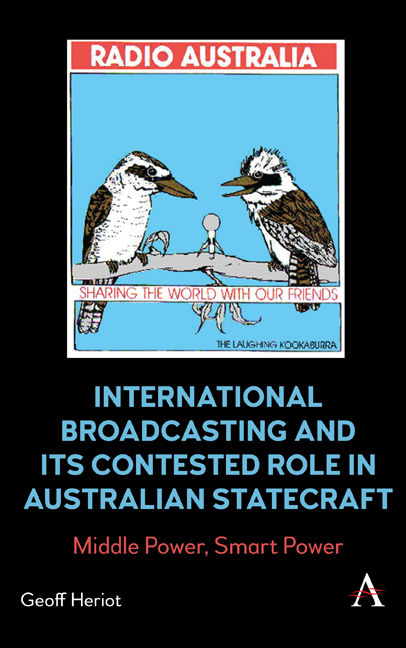 International Broadcasting and Its Contested Role in Australian Statecraft
International Broadcasting and Its Contested Role in Australian Statecraft Book contents
- Frontmatter
- Dedication
- Contents
- List of Figures
- Foreword
- Acknowledgements
- Chapter One Introduction
- Chapter Two Media and the Contest of Ideas
- Chapter Three International Broadcasting and Its Discursive Properties
- Chapter Four Mobilising ‘Softer’ Power in a Hard World
- Chapter Five Australia’s ABC: State Interests, National Evolution
- Chapter Six Purpose, Performance and Evaluation
- Chapter Seven Modernising the ABC
- Chapter Eight Policy, Priorities and Qualified Independence
- Chapter Nine Engaging with Intercultural Audiences
- Chapter Ten Indonesia, the Crucible
- Chapter Eleven Strategic Contingency and War
- Chapter Twelve Looking to the New Disorder
- Index
Foreword
Published online by Cambridge University Press: 15 November 2023
- Frontmatter
- Dedication
- Contents
- List of Figures
- Foreword
- Acknowledgements
- Chapter One Introduction
- Chapter Two Media and the Contest of Ideas
- Chapter Three International Broadcasting and Its Discursive Properties
- Chapter Four Mobilising ‘Softer’ Power in a Hard World
- Chapter Five Australia’s ABC: State Interests, National Evolution
- Chapter Six Purpose, Performance and Evaluation
- Chapter Seven Modernising the ABC
- Chapter Eight Policy, Priorities and Qualified Independence
- Chapter Nine Engaging with Intercultural Audiences
- Chapter Ten Indonesia, the Crucible
- Chapter Eleven Strategic Contingency and War
- Chapter Twelve Looking to the New Disorder
- Index
Summary
Since the end of the Cold War, few foreign-policy concepts have drawn as much attention as soft power – the ability to influence the behaviour of others through the power of culture, political ideals and sound foreign policies. The normative underpinning was that a soft power–minded foreign policy could strengthen a country’s reputation and hence its ability to shape and influence its international environment. When Joseph Nye Jr. published Bound to Lead in 1990, coining the soft-power term as a conceptual rebuttal to Paul Kennedy’s American-decline thesis in The Rise and Fall of Great Powers, he could hardly have predicted the worldwide scholarly and policy debates that it has generated in the decades since. Nye himself has been an active and generous participant in those debates, engaging his critics – from leading scholars and practitioners to students at the School of Marxism at Peking University – with several books and many articles. Geoff Heriot joins these debates at an auspicious time.
In its simplest and most intuitive form, soft power is the opposite of hard power, the latter usually associated with the use or threatened use of military force and coercive economic measures. A key question of the many that were raised in both policy and scholarly debates was how to find a balance between hard and soft power. A conceptual compromise was developed as smart power, devised and promoted in a 2007 independent commission report co-authored by Nye under the auspices of the influential Washington DC-based Center for Security and International Studies (CSIS). Smart power was seen as ‘the successful combination of hard and soft power resources into effective strategy’. For Nye, smart power, more so than soft power, ‘was deliberately prescriptive rather than just analytical’.
The smart power term was subsequently used by US secretary of state Hillary Clinton in the Obama administration and in many other countries as well, tellingly in China. If a weakness of soft power was its perception as a blunt instrument largely out of reach from governmental facilitation in democracies, then smart power honed it. This refinement allowed for a more judicious balance between ‘measured national self-interest’ (to paraphrase Princeton University’s John Ikenberry) and ‘good international citizenship’ (in the words of former Australian foreign minister Gareth Evans).
- Type
- Chapter
- Information
- International Broadcasting and Its Contested Role in Australian StatecraftMiddle Power, Smart Power, pp. ix - xiiPublisher: Anthem PressPrint publication year: 2023
